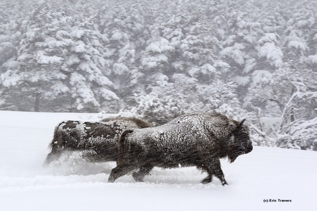‘Seasons’ Argues for Environmental Protection

Photo via Eric Travers/Courtesy of Music Box Films
“Seasons”, a film directed by Jacques Perrin and Jacques Cluzud, illustrates the beauty of nature through graceful, isolated footage of animals in the wild and limited human actors.
November 17, 2016
Directors Jacques Perrin and Jacques Cluzaud have teamed up for another beautiful and enthralling nature documentary. After covering both air and water in their previous films, “Winged Migration” and “Oceans,” the pair have grounded themselves with “Seasons.” Opening with a beautiful landscape shot of water buffalo fighting the winter, the film immediately pulls in its viewers with exquisite visual poetry. It focuses on climate change as well as the detrimental effects of hunting and farming. Through an artful lens, it urges people to be aware of how their actions affect the natural world.
“Seasons,” narrated in French with English subtitles, primarily consists of showing nature through the eyes of animals in Europe. The movie begins by showcasing life before human civilization, pointing out that signs of human life are limited to just a few piles of rocks. The first glimpse of an actual human being, dressed in animal skins, does not occur until a brief shot of a man’s eyes about 17 minutes into the film.
The film continues to rarely show people, and when they do appear, they are just barely glimpsed through the eyes of wolves or other animals. This perspective makes viewers feel like members of a prehistoric family making its way through the forest. It is only three-quarters of the way through that the film includes significant human presence.
The message is clear: the human presence in Europe is relatively recent in the grand scheme of things, but since bursting onto the scene we have massively changed the face of the earth.
The original French title “Les saisons” (translated to “Seasons”) represents many important themes of the film. There are, of course, the physical seasons that cycle throughout the film and give a rhythmic cadence of passing time. The seasons of life represented by scenes of birth, family life and death. The third sort of seasons, which ends up being the major point of the film, relates to the possible seasons of humanity. The documentary presents the first season of humanity as a prolonged childhood that lasted nearly 80,000 years, followed by a swift maturation during which humanity masters the planet.
Through these many narrative strategies, the film poses the question of whether or not we can, as a species, survive another cycle of humanity, or if we will die out as a result of not protecting the environment that we depend on. Some of the most arresting visual images of the film showcase various animals of prehistoric Europe living their lives. These include large mammals like horses, wolves, foxes and boar which fight and play among themselves as well as hunt each other.
This beautiful film is sly in achieving its ultimate aim. While 80 percent of the film feels like a nature documentary, it is ultimately a call to protect our environment. “Seasons” achieves this by a range of effective narrative strategies that pull us in, helping us see the world with a much wider perspective. It ultimately asks viewers if they will make the changes necessary for humanity to survive.
Email Sophie Bennett at [email protected].























































































































































